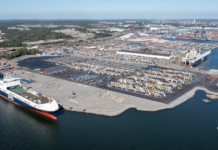- Dramatically low water levels are causing chaos in Germany.
- Drought-like conditions have hit nearly 90 percent of the country in 2018.
- Experts fear this could be a sign of things to come in the future.
In Lake Constance, a new island has emerged. In Berlin, a river is flowing backward. A large number of lakes and ponds are seeing dead fish along their banks. Barges are hardly being loaded so they don’t run aground.
This is the scene in Germany after a long and dry summer has left the country’s lakes and rivers at record low levels. The levels are causing chaos for the inland shipping industry while causing environmental damage and billions of dollars in losses. Experts fear this could be a sign of what’s to come as global temperatures rise.
The drought-like conditions have hit nearly 90 percent of the country this year.
In Magdeburg, the Elbe River has been so low that no ships carrying goods south to Leipzig or on to the Czech Republic have been able to pass through since the end of June, said Hartmut Rhein of the city’s waterways and shipping department.
The river’s down to a depth less than 20 inches there when at least double that level is needed for normal shipping traffic, he said.
“At the moment the only possibility is to completely unload ships and transfer their cargoes to other means of transportation,” he said.
The situation is similar across Germany. The mighty Rhine has hit its lowest water levels ever at several points, and other major rivers like the Danube, the Weser and the Main are all far below normal.
On the waterways that are still navigable, the lower water levels have actually led to increased shipping traffic, as companies pack less weight onto boats so they don’t ride so low in the water. That means they must send more vessels out to carry the same amount of freight.
“All the ships on the Rhine are going around the clock to transport goods that would normally be on fewer ships,” said Rolf Nagelschmidt of Cologne’s waterways and shipping office. “At the moment, everything that can float is being loaded up.”
That has sent freight prices skyrocketing, and some costs are already being felt by consumers, with higher prices at gas pumps and for home heating oil.
Read more on The Weather Channel.








